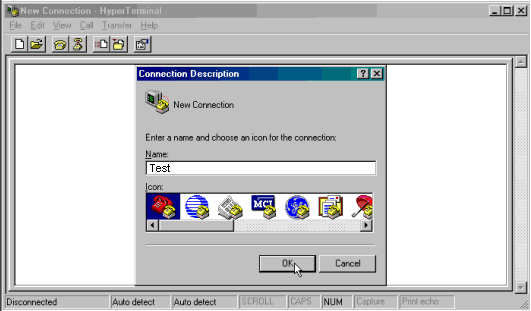- What Is Windows Hyperterminal
- Apc Ups Windows Hyperterminal Software Commands Download
- Download Windows Hyperterminal
PowerChute Business Edition v9.5 (32 bit systems only) UPS management, graceful shutdown, and energy management software for servers and workstations using dedicated serial or USB connections. PowerChute Business Edition v9.5 (32 bit systems only) UPS management, graceful shutdown, and energy management software for servers and workstations using dedicated serial or USB connections.
So we’re using several types of UPS’s at our clients, and sometimes bump into generic USB UPS systems too. To monitor these we use a couple of methods that all have benefits and downsides. Let’s get started.
If a generic USB UPS is installed, Windows Server recognizes this as a Battery Unit. The status is sent to the server by using a generic Windows Driver called “Microsoft Compliant Control Method Battery” which is quite the mouthfull. The good thing is that with this driver we can use a couple of small PowerShell commands to find the exact status of the battery.
USB UPS systems
The script gets the battery status out of WMI, it shows if the machine is running on battery or not, and you can alert on this. We’ve set our systems up to make sure that when the battery status changes from anything but “Not using battery” it alerts, and possibly shuts down the machine.
Another thing to pay attention to is the Battery Status – Most APCs and Dell’s connected to USB even tell the OS if the battery is in a warning state or failed, you should alert on anything but “OK” for the status.
We can’t really monitor network UPS systems with this, as they do not get their data in w32_battery, so we’ll have to use a couple of different solutions for this. I’ll try covering this in a future blog. As always, happy PowerShelling!
Hyperterminal is a communications program that isincluded free with Windows 95 and later. Although the program has somequirks, it's handy for sending data to serial displays. This tip sheetshows how to configure the program, and lists some known peculiarities.
Hyperterminal's publisher, Hilgraeve, offersfree and low-cost upgrades to the program, as well as more advancedcommunication software. It's very likely that most or all of the issueslisted here will be solved by downloading a new release from their site.
| NOTE: If you just want to demo ourserial displays, try our free Windows serial-sender utility. Download the program here. |
Setting up Hyperterminal
In a normal installation of Windows 95 or later,Hyperterminal is automatically installed under Programs:Accessories, soyou access it as follows:
- Click Start
- Select Programs
- Select Accessories
- Select Hyperterminal folder
- Select Hypertrm.exe
Upon launching Hyperterminal, you'll be given theopportunity to name and assign an icon to your settings. You may chooseany name/icon. Afterwards, a series of dialog boxes will appear. Enterthe following settings:
Phone Number
- Click the drop-down arrow by Connect Using
- Select Direct to COM1 (or 'directto' the port you intend to use)
- Click OK
COM1 Properties, Port Settings
- Bits per Second: select 9600(or desired baud rate)
- Data Bits: select 8
- Parity: select None
- Stop Bits: select 1
- Flow Control: select none
- Click OK
Advanced

- Select Defaults
- Click OK
- Click OK
This will get you into the main Hyperterminal window.There are still a few more settings to make. Pull down the Filemenu and select Properties.
Properties Dialog
What Is Windows Hyperterminal
- Click Settings tab
- Check Terminal Keys
- Set Emulation to AutoDetect
- Click ASCII Setup button
- Under ASCII Sending, check Echotyped characters locally
- Under ASCII Receiving, check Appendline feeds to incoming line ends
- Click OK
- Click OK
Using Hyperterminal
Once you've configured the program, make sure to saveyour configuration for reuse. If you launch the program using yourconfiguration icon, your settings will be loaded automatically.
With the settings listed above, anything you type intothe Hyperterminal window will be sent out the serial port. You can alsosend most control characters by holding down the Ctrlkey and typing the appropriate letter. For example, control-L(formfeed) is recognized by our BPP-, BGX-, VFD-, and SGX-seriesdisplays as a clear-screen instruction. Hold Ctrland type L to clear the LCD screen.
Apc Ups Windows Hyperterminal Software Commands Download
You can also use an old DOS trick to send particularASCII values that may not have control-key equivalents. Hold down the Altkey and type the decimal ASCII value on the keyboard's numerickeypad (not the number keys along the top of the keyboard),then release Alt. Precede the number with a 0(zero). For example, to send ASCII 133, press and hold Alt, type 01 3 3 on the keypad, then release Alt.

Don't leave out the 0 (zero) preceding the number! Ifyou do, the actual value sent can be changed in odd ways. For example,ASCII 14 sent as Alt-down 1 4 Alt-upworks fine, but ASCII 15 sent as Alt-down 1 5Alt-up gets translated to ASCII 164.
The smart customer who pointed out the necessity of theleading zero speculates that it has to do with Windows' conversion ofcharacter codes to the DOS character set.
Corrupted Config Files
Download Windows Hyperterminal
Saved configurations can be corrupted in odd ways. Themost obvious symptom is that typing the same character three times in arow causes the third instance of the character to be sent incorrectly.In other cases, the terminal program fails to work altogether. The onlyfix we know of is to create a new configuration from scratch, asdescribed above.